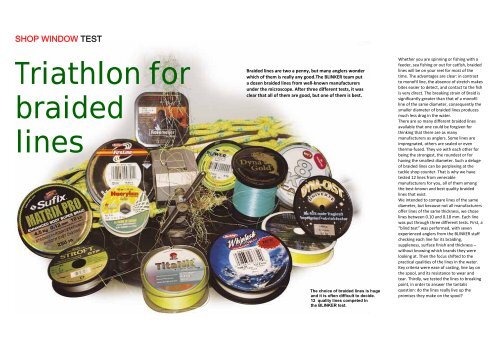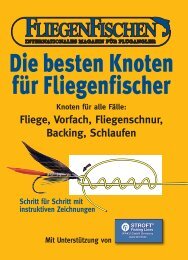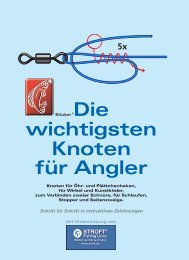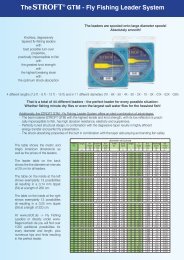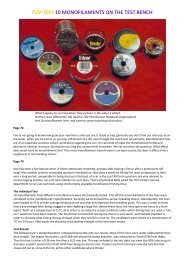SHOP WINDOW TEST - STROFT Fishing Lines
SHOP WINDOW TEST - STROFT Fishing Lines
SHOP WINDOW TEST - STROFT Fishing Lines
Create successful ePaper yourself
Turn your PDF publications into a flip-book with our unique Google optimized e-Paper software.
<strong>SHOP</strong> <strong>WINDOW</strong> <strong>TEST</strong><br />
Triathlon for<br />
braided<br />
lines<br />
Braided lines are two a penny, but many anglers wonder<br />
which of them is really any good.The BLINKER team put<br />
a dozen braided lines from well‐known manufacturers<br />
under the microscope. After three different tests, it was<br />
clear that all of them are good, but one of them is best.<br />
The choice of braided lines is huge<br />
and it is often difficult to decide.<br />
12 quality lines competed In<br />
the BLINKER test.<br />
Whether you are spinning or fishing with a<br />
feeder, sea fishing or out for catfish, braided<br />
lines will be on your reel for most of the<br />
time. The advantages are clear: in contrast<br />
to monofil line, the absence of stretch makes<br />
bites easier to detect, and contact to the fish<br />
is very direct. The breaking strain of Braid is<br />
significantly greater than that of a monofil<br />
line of the same diameter, consequently the<br />
smaller diameter of braided lines produces<br />
much less drag in the water.<br />
There are so many different braided lines<br />
available that one could be forgiven for<br />
thinking that there are as many<br />
manufacturers as anglers. Some lines are<br />
impregnated, others are sealed or even<br />
thermo‐fused. They vie with each other for<br />
being the strongest, the roundest or for<br />
having the smallest diameter. Such a deluge<br />
of braided lines can be perplexing at the<br />
tackle shop counter. That is why we have<br />
tested 12 lines from venerable<br />
manufacturers for you, all of them among<br />
the best‐known and best quality braided<br />
lines that exist.<br />
We intended to compare lines of the same<br />
diameter, but because not all manufacturers<br />
offer lines of the same thickness, we chose<br />
lines between 0.10 and 0.18 mm. Each line<br />
was put through three different tests. First, a<br />
“blind test” was performed, with seven<br />
experienced anglers from the BLINKER staff<br />
checking each line for its braiding,<br />
suppleness, surface finish and thickness –<br />
without knowing which brands they were<br />
looking at. Then the focus shifted to the<br />
practical qualities of the lines in the water.<br />
Key criteria were ease of casting, line lay on<br />
the spool, and its resistance to wear and<br />
tear. Thirdly, we tested the lines to breaking<br />
point, in order to answer the tantalis<br />
question: do the lines really live up the<br />
promises they make on the spool?
<strong>SHOP</strong> <strong>WINDOW</strong> <strong>TEST</strong><br />
1. The blind test<br />
In the blind test for suppleness,<br />
rigidity, surface structure and<br />
braiding, one thing became clear<br />
to us very quickly; it is not always<br />
obvious from looking at and<br />
feeling the lines how the<br />
manufacturers arrive at their<br />
respective diameters. Some lines<br />
felt much thicker than<br />
advertised. This is because there<br />
is no uniform method of<br />
determining the diameter of<br />
braided lines. Many lines are not<br />
round but flat, so no correct<br />
diameter can be given. We found<br />
the manufacturers’ specifications<br />
equally unreliable; one of the<br />
lines with the smallest indicated<br />
diameter was in our judgment<br />
quite clearly the thickest and a<br />
0.18 mm line seemed more like a<br />
0.08 or 0.10 mm.<br />
The surface structure of the<br />
various lines also exhibited<br />
substantial differences. Some felt<br />
very rough, while others were so<br />
smooth that they could almost<br />
have been taken for monofil. This<br />
is because some brands are<br />
sealed or waxed to increase their<br />
suppleness.<br />
All manufacturers try to<br />
produce the roundest possible<br />
lines, which are easy to cast and<br />
absorb little water. However,<br />
only a few of the lines that we<br />
tested can be described as<br />
anything like round. At first sight,<br />
in fact, some of them look<br />
distinctly flat.<br />
In terms of suppleness or rigidity,<br />
our assessments ranged from<br />
very stiff to very supple.<br />
In the blind test, the surface, suppleness and braiding were<br />
examined and compared – with surprising results: lines with<br />
similar manufacturers’ details exhibited significant differences.<br />
The choice of line always<br />
depends on personal preference.<br />
Some anglers like smaller<br />
diameter lines to be a bit stiffer,<br />
so that the line doesn’t get<br />
caught around the rings when<br />
casting or twist itself into tangles<br />
when limp. Others prefer a more<br />
flexible line that runs quickly off<br />
the reel allowing one to place<br />
baits and fish lures with<br />
accuracy. Despite these different<br />
preferences, three lines emerged<br />
as the winners of the “dry test”<br />
in the office.<br />
Stroft GTP from<br />
Waku, type 2;<br />
0.18 mm, tensile<br />
strength 4.0 kg:<br />
Despite its large indicated<br />
diameter (type 2 = 0.18 mm), this<br />
line was judged extremely thin,<br />
and the majority of the testers<br />
liked its suppleness. It also re‐<br />
ceived best marks for having a<br />
very round cross section.<br />
Jigmaster Super<br />
Braid from Roze<br />
meijer; 0.10mm,<br />
tensile strength<br />
6.1 kg:<br />
For the Jigmaster, the indicated<br />
diameter tallied with the testers’<br />
estimates. The line felt very thin,<br />
and its round braiding and<br />
smooth surface also scored<br />
highly.<br />
Berkley Fireline;<br />
0.12 mm, tensile<br />
strength 6.8 kg:<br />
The Fireline scores with its<br />
smooth surface and is rated<br />
practically round. It is a front<br />
runner for lovers of stiffer lines.<br />
2. The practical test<br />
Kitted out with rods, reels and<br />
braided lines, we went down to<br />
the water for the practical test,<br />
where we compared the casting<br />
qualities and behaviour of the<br />
lines on the reel. First, we looked<br />
at the reels, to assess the way<br />
the lines lay. Most of the lines<br />
tested lay relatively smoothly on<br />
the reel, so we were able to<br />
award good marks across the<br />
board in this category. Two lines<br />
stood out especially, receiving an<br />
unanimous “very good”. Then we<br />
moved on to test the casting<br />
qualities of the lines. At first we<br />
were not sure whether we would<br />
find any differences at all<br />
between the various lines; but in<br />
practice, it only took a few casts<br />
to remove our doubts: although<br />
no line came out as<br />
“unsatisfactory”, small but subtle<br />
differences could be seen. Some<br />
lines shot off the reel like<br />
greased lightning, and even a<br />
casual underarm cast threw<br />
them astonishing distances.<br />
Other lines, on the other hand,<br />
felt slightly wiry and were not so<br />
easy to cast.<br />
Finally, we tested their resistance<br />
to abrasion. Particularly where<br />
there are a lot of stones, mussel<br />
beds or sunken pieces of wood in<br />
the water, the line needs to be as<br />
abrasion resistant as possible. A<br />
good fish on a damaged line is<br />
usually a lost fish. In order to<br />
simulate these conditions, the<br />
lines were drawn across a rusty<br />
and sharp‐edged surface. The<br />
differences in the resistance to<br />
abrasion were amazing; two lines<br />
snapped after just a few rubs,<br />
while others proved much more<br />
hard‐wearing. The top performer<br />
actually turned out to be ten<br />
times stronger than the weakest<br />
line. However, this result needs<br />
to be treated with caution:<br />
thicker lines have more<br />
individual strands and a<br />
significantly larger surface area.<br />
This makes them much less<br />
susceptible to wear.<br />
The practical test also produced<br />
three clear winners:<br />
Matrix Pro from<br />
Sufix;0.12 mm,<br />
indicated tensile<br />
strength 4.5 kg:<br />
The Matrix Pro stands out; it lies<br />
well on the spool and casts out‐<br />
standingly. With this line, you<br />
can hit distant spots<br />
accurately.<br />
As with all<br />
three winners<br />
of the practical test<br />
marks only had<br />
to be deducted<br />
for resistance to wear.<br />
Jigmaster Super Braid<br />
from Rozemeijer;<br />
0.10 mm, tensile<br />
strength 6.1 kg:<br />
Its way it lies on the spool is first‐<br />
rate, with no crooked winds to<br />
spoil the extremely good overall<br />
picture. In casting too, the<br />
Jigmaster makes an excellent<br />
impression.<br />
Stroft GTP from Waku,<br />
type 2; 0.18 mm,<br />
tensile strength 4.0 kg:<br />
As in the blind test, the Stroft<br />
GTP emerged from the practical<br />
test as one of the best lines. It<br />
winds in smoothly and lies very<br />
evenly on the reel. Its suppleness<br />
allows it to be cast great dis‐<br />
tances.<br />
On the water, the<br />
different properties<br />
of the braided<br />
lines became clear:<br />
when casting,<br />
some lines ran<br />
off the reel very<br />
easily, while others<br />
felt rather stiff<br />
and slowed the bait<br />
on the cast.<br />
Differences could be seen in<br />
the way the lines lay on the<br />
reels. Even on the same reel,<br />
not all lines lay equally well.
<strong>SHOP</strong> <strong>WINDOW</strong> <strong>TEST</strong><br />
Engineer and angler Tomek Nimiero from the<br />
German Fisheries Research Institute in Hamburg<br />
ran the tensile test. The manufacturers’ claims<br />
were tested on a tensile testing machine (in the<br />
background), which is normally used to test the<br />
tensile strength of fishing nets.<br />
For the breakage test, the braided<br />
lines were not knotted but tied on<br />
with knot-free connectors (right).<br />
This is the only reliable way to<br />
measure linear tensile strength.<br />
3. The breakage test<br />
The breaking strain test was the<br />
chance for the braided lines to<br />
show whether their tensile<br />
strength really matched the<br />
manufacturers’ claims. After all,<br />
the very worst scenario would<br />
be losing a good fish because<br />
the line is weaker than stated.<br />
We wanted to know the exact<br />
breaking strains, so we made an<br />
appointment with the German<br />
Fisheries Research Institute in<br />
Hamburg. Under the expert<br />
guidance of Tomek Nimiero, an<br />
engineer at the Institute, the<br />
lines were checked for their tensile<br />
strength on a tried and<br />
tested tensile testing machine.<br />
As a knot results in a weak<br />
point, we did not tie the lines,but<br />
attached them to the machine<br />
with knot-free connectors. To<br />
rule out any random result, each<br />
line was stretched to breaking<br />
point three times. This test found<br />
that only a few lines actually<br />
achieve their indicated tensile<br />
strength. Particularly shocking<br />
were the test results for one line<br />
which failed all three trials at<br />
50% strain.But there is also<br />
good news to report: three lines<br />
held up significantly better than<br />
stated on the spool.<br />
After our three tests, there<br />
is a clear winner, and it is<br />
the Stroft GTP from Waku.<br />
Compared to its indicated<br />
diameter, it was judged<br />
extremely thin, round and<br />
supple. On the water, it<br />
scored with its very good<br />
performance on the reel<br />
and good casting qualities.<br />
In the tensile test, it<br />
withstood a greater load<br />
then advertised on the<br />
spool.<br />
And these are the three strongest<br />
lines:<br />
Tortue Nacrylan Soleil;<br />
0.12 mm, indicated<br />
tensile strength 5.0 kg<br />
(supplied via VMC):<br />
With an indicated tensile strength<br />
of 5.0 kg, the Nacrylan ranks a<br />
little below the middle of the range<br />
when compared with other<br />
braided lines of the same diameter.<br />
However, this proved to be<br />
an underestimate, as it only broke<br />
under a load of 7.2 kg (average),<br />
a full 2.2 kg more than advertised.<br />
Matrix Pro from Sufix;<br />
0.12 mm, indicated<br />
tensile strength 4.5 kg:<br />
The Matrix Pro also proved to be<br />
more resistant to breakage than<br />
advertised, holding not just the<br />
indicated 4.5 kg, but breaking at<br />
5.7 kg (average) – a bonus of 1.2<br />
kg.<br />
Stroft GTP from Waku,<br />
type 2; 0.18 mm,<br />
indicated tensile<br />
strength 4.0 kg:<br />
For the third time, the Stroft GTP<br />
comes out in the top group. It<br />
easily handled a load of 4.0 kg,<br />
and only gave out at 4.7 kg<br />
(average). Still 700 g more than it<br />
says on the spool.<br />
1 st place: Stroft GTP<br />
from Waku, type 2; 0.18<br />
mm, indicated tensile<br />
strength 4.0 kg<br />
The winners:<br />
Highly magnified<br />
A glance through the microscope makes clear<br />
what you can already feel with your fingers. The<br />
lines have very different structures and surfaces.<br />
Here are three examples:<br />
With this line,<br />
the individual<br />
strands and<br />
their braiding<br />
can be very<br />
clearly seen.<br />
Here one sees<br />
how the thick‐<br />
ness of a line<br />
can vary over a<br />
very short<br />
section.<br />
This coated line<br />
shows residue<br />
on the upper<br />
edge.<br />
We will not keep the 2 nd<br />
and 3 rd places from you<br />
either. The Matrix Pro from<br />
Sufix did not do so well in<br />
the blind test, but was<br />
always in the top group<br />
otherwise.<br />
2 nd place:<br />
Matrix Pro<br />
from Sufix;<br />
0.12 mm,<br />
indicated<br />
tensile<br />
strength 4.5 kg<br />
Because of its much better<br />
tensile strength, it beat the<br />
Jigmaster from Rozemeijer<br />
into second place by a nose.<br />
3 rd place:<br />
Jigmaster Super<br />
Braid from<br />
Rozemeijer;<br />
0.10 mm,<br />
tensile<br />
strength<br />
6.1 kg


